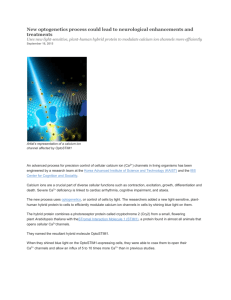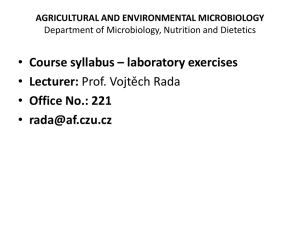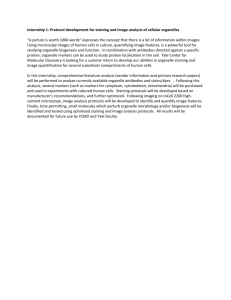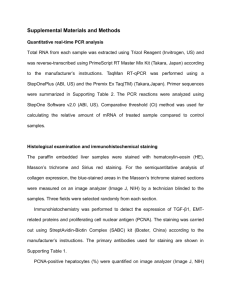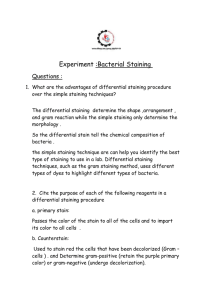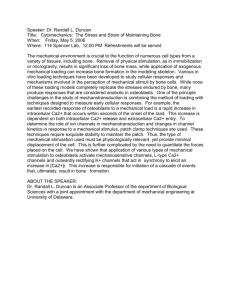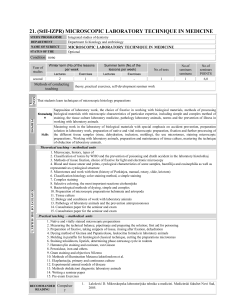Supplementary Materials and Methods (docx 19K)
advertisement
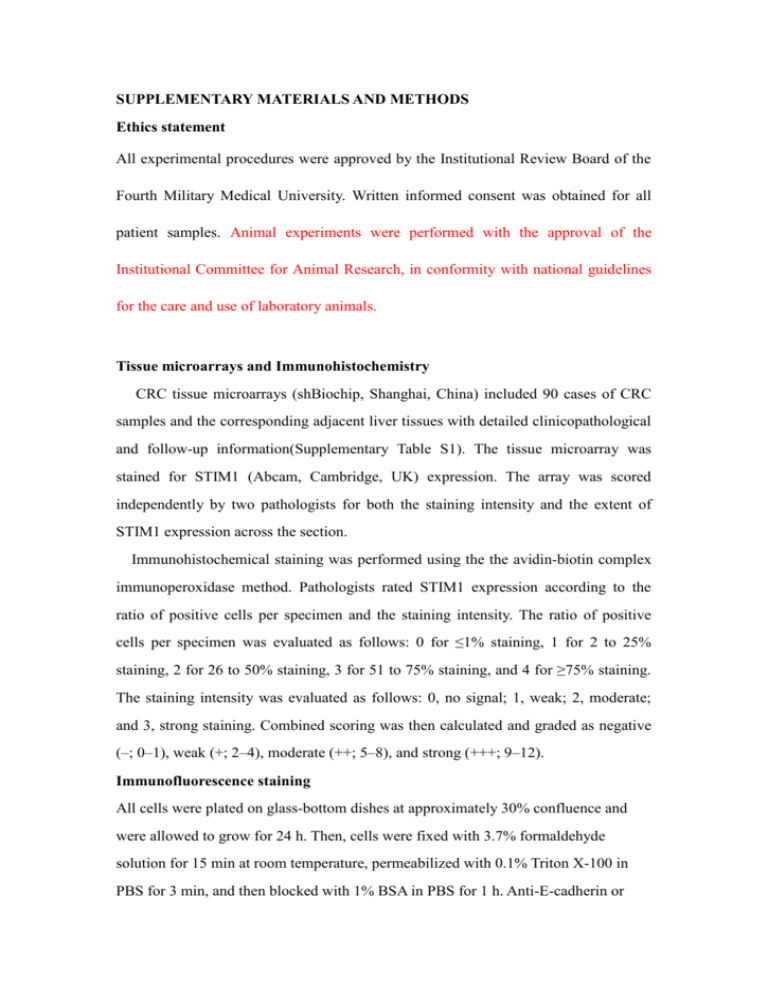
SUPPLEMENTARY MATERIALS AND METHODS Ethics statement All experimental procedures were approved by the Institutional Review Board of the Fourth Military Medical University. Written informed consent was obtained for all patient samples. Animal experiments were performed with the approval of the Institutional Committee for Animal Research, in conformity with national guidelines for the care and use of laboratory animals. Tissue microarrays and Immunohistochemistry CRC tissue microarrays (shBiochip, Shanghai, China) included 90 cases of CRC samples and the corresponding adjacent liver tissues with detailed clinicopathological and follow-up information(Supplementary Table S1). The tissue microarray was stained for STIM1 (Abcam, Cambridge, UK) expression. The array was scored independently by two pathologists for both the staining intensity and the extent of STIM1 expression across the section. Immunohistochemical staining was performed using the the avidin-biotin complex immunoperoxidase method. Pathologists rated STIM1 expression according to the ratio of positive cells per specimen and the staining intensity. The ratio of positive cells per specimen was evaluated as follows: 0 for ≤1% staining, 1 for 2 to 25% staining, 2 for 26 to 50% staining, 3 for 51 to 75% staining, and 4 for ≥75% staining. The staining intensity was evaluated as follows: 0, no signal; 1, weak; 2, moderate; and 3, strong staining. Combined scoring was then calculated and graded as negative (–; 0–1), weak (+; 2–4), moderate (++; 5–8), and strong (+++; 9–12). Immunofluorescence staining All cells were plated on glass-bottom dishes at approximately 30% confluence and were allowed to grow for 24 h. Then, cells were fixed with 3.7% formaldehyde solution for 15 min at room temperature, permeabilized with 0.1% Triton X-100 in PBS for 3 min, and then blocked with 1% BSA in PBS for 1 h. Anti-E-cadherin or anti-vimentin monoclonal antibody was incubated with blocked cells for 2 h. After washing with PBS, cells were incubated with secondary antibody for 1 h,samples were mounted with DAPI (Vector Laboratories, Burlingame, CA) according to the manufacturer’s protocol. The Immunostained cells were detected and visualized , images were captured by a scanning confocal microscope(FlUOVIEW FVLIOi, OLYMPUS). RNA extraction and real-time quantitative reverse transcription polymerase chain reaction Total RNA was extracted from CRC cells and tissues using TRIzol reagent. For the detection of miR-185 expression, stem-loop RT-PCR was performed using an All-in-One™ miRNA qRT-PCR Detection Kit (GeneCopoeia, Rockville, MD, USA) according to the manufacturer’s instructions. Briefly, the extracted RNA was reverse-transcribed in the presence of a poly-A polymerase with an oligo-dT adaptor. Real-time PCR was performed with SYBR green buffer, a forward primer for the mature miRNA sequence, and a universal adaptor reverse primer. The relative expression levels of miR-185 were calculated using the comparative threshold cycle (CT) method and were then normalized to the expression levels of U6 small RNA . The primers used for the detection of miR-185 and U6 were purchased from GeneCopoeia (HmiRQP0247, HmiRQP9001). To assess the mRNA expression levels of STIM1, qPCR was performed using a TaKaRa SYBR Green PCR Kit (TaKaRa). Glyceraldehyde 3-phosphate dehydrogenase (GAPDH) or beta-actin was used to normalize the mRNA expression levels. The following primers were used: STIM1, 5'-GAATTGACAAGCCCCTGTGT-3' (sense) and 5'-ATGACTTCCATGCCTTCCAC-3' (anti-sense); GAPDH, 5'-CCGGGAAACTGTGGCGTGATGG-3' 5'-AGGTGGAGGAGTGGGTGTCGCTGTT-3' (sense) (anti-sense). and beta-actin, 5'-CTCCATCCTGGCCTCGCTGT-3' (sense); 5'-GCTGTCACCTTCACCGTTCC-3' (anti-sense). STIM2, 5'-ATGTCACTGAGTCCACCATGCTTTA-3' (sense); 5'-TCTCTGTGCAGATGGCTGTGTTTA-3' (anti-sense). ORAI1, 5′-CGTATCTAGAATGCATCCGGAGCC-3′(sense); 5′-CAGCCACTATGCCTAGGTCGACTAGC-3′(anti-sense). ORAI2, 5'-GGGTCTTCGTGTCACAGCTTCA-3' (sense); 5'-GCACTCCTGCAGAGCACACTTTAG-3' (anti-sense). 5'-ACGCTATGCACCAAACTTGTTCTC-3' ORAI3, (sense); 5'-CCCAACCCTTGCTAAGGACTCA(anti-sense) All reactions were performed in triplicate. In vitro migration and invasion assay A 24-well transwell plate (8 mm pore size; Corning, NY) was used for this assay. For migration assays, the cells were added to the top chamber lined with a non-coated membrane. For invasion assays, the chamber inserts were coated with 200 mg/ml Matrigel (BD Biosciences, San Jose, CA) and dried overnight under sterile conditions. The cells were then placed in the top chamber. In both assays, the cells were suspended in medium without either serum or growth factors, and medium supplemented with serum was used as a chemoattractant in the lower chamber. After incubation at 37℃ in 5% CO2 for 24 h, the top chambers were swabbed to remove residual cells. Invading cells on the undersides of the membranes were fixed in 100% methanol for 10 min, air-dried, stained with 0.1% crystal violet and quantified with a microscope. Five random fields were analyzed for each insert. The assays were conducted in triplicate in three independent experiments. Tail vein metastatic assay To produce experimental metastasis, cells were washed and resuspended in PBS. Five-week-old BALB/C-nu/nu nude mice obtained from the Shanghai Laboratory Animal Center of China were injected into the lateral tail vein, and the animals were maintained in a sterile animal facility. Each tumor cell subline was injected into ten mice. After ten weeks, the mice were killed, and the lungs and liver were examined for metastases. Tumor tissues derived from various organs were dissected and examined histologically. The experiments were repeated two to three times. Western blotting analysis Cell proteins were extracted and separated with SDS-PAGE gels, and western blot analysis was performed according to standard procedures. β-actin expression was assessed as a loading control. Anti-STIM1 (Abcam, Cambridge, MA), anti-E-cadherin, anti-Vimentin and anti-β-actin (Santa Cruz, CA) antibodies were used for the western blot experiments. Measurement of intracellular Ca2+ Cells seeded on coverslips were loaded with 3μM Fura 2-AM by incubation in Hank’s balanced salt solution (136.9mM NaCl, 4.2mM NaHCO3, 0.3mM Na2HPO4, 5.4mM KCl, 0.4mM KH2PO4, 0.5mM MgCl2, 0.4mM MgSO4, 5.5mM D-Glucose, 1.3mM CaCl2, 8.0mM Hepes, pH7.2) for 30 min in the dark at room temperature, followed by washing and an additional 30 min incubation to ensure full de-esterification. Coverslips were then transferred to a perfusion chamber. For every coverslip, at least 10 cells were measured simultaneously (excited at 340 and 380nm with emission at 510 nm) using a ×20 objective xenon lamp (Lambda DG4, Sutter Instrument Company, Novato, CA, USA) equipped with a Nikon epifluorescence microscope (TE2000-U; Nikon, Tokyo, Japan) and band-pass filters for wavelengths of 340 and 380 nm. Based on the equation: [Ca2+]c=Kd×(Sf2/Sb2) ×(R-Rmin)/(Rmax-R), the [Ca2+]c can be represented by the ratio (R) of 340/380nm fluorescence images. Cells were first perfused with Hank’s balanced salt solution containing 1.3mM CaCl2 to determine the resting cytosolic free Ca2+ concentration ([Ca2+]c). Then, the buffer was replaced by Ca2+-free and 2mM ethylene glycol tetraacetic acid-containing Hank’s balanced salt solution to remove extracellular Ca2+ . Once the 340 nm/380nm ratio reached a steady state, Thapsigargin(TG) was added to achieve final 10 mM concentration and Ca2+ released from ER ([Ca2+]ER) was monitored. When ER Ca2+ was depleted, 1.3mM CaCl2 was added back into the perfusate to record Ca2+ influx (SOCE). Statistical analysis The data are presented as the means ± standard errors of the mean (SEM) or medians (ranges). Student’s t-test (two-tailed) or a one-way ANOVA test was employed to analyze the in vitro and in vivo data unless otherwise indicated (χ2 test). The non-parametric Mann-Whitney test was used to analyze the relationship between STIM1 or miR-185 expression levels and various clinicopathologic characteristics. The survival rates were determined using the Kaplan–Meier method. Statistical tests were performed using SPSS 17.0 software (Chicago, IL, USA). P < 0.05 was defined as statistically significant. * P < 0.05; **P < 0.01.
